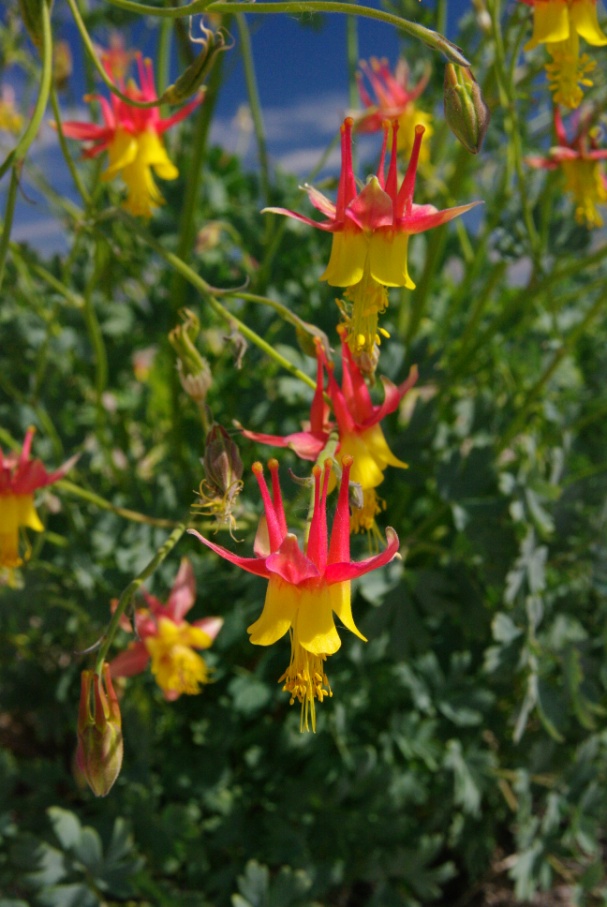Oil Shale Columbine in the Landscape

Stephen Love, University of Idaho
Scientfic Name: Aquilegia barnebyiCommon Name: Oil Shale Columbine
Description: Oil shale columbine is a hardy, very long-lived perennial. Shoots emerge early in the spring from a cluster of fleshy crowns. The plants are large for the genus, often growing to a height greater than 3 feet. The foliage consists of dense, attractive, divided leaves that are pleasant shades of bluish-green. The nodding flowers grow on long, slender stems. The blooms have medium length spurs and range in color from light yellow to peach to attractive combinations of fuchsia and dark yellow. Bloom period is up to 8 weeks long in late spring into summer, with some rebloom in late summer. Oil shale columbine is adapted to a wide range of growing conditions and can withstand moderately dry conditions, making it a good subject for dry shade or beds and borders in full sun.
Native Habitat: Aquilegia barnebyi is native to the Green River drainage of northeastern Utah and western Colorado. It grows on cliffs and talus slopes, often on oil-bearing formations. Habitat can be moderately xeric to moist at elevations ranging from 4,800 to 8,500 feet.
Cultural Requirement
Soil: Tolerates a wide range of soils, with best growth on loams and clays. Can tolerate moist conditions, but soil must be well-drained. Withstands soils with high pH.
Moisture Tolerance: Thrives under a wide range of conditions, from moist to moderately dry. Plants will not survive under non-irrigated conditions in climates with less than 15 to 20 inches of annual precipitation, but will do well in dry places with occasional supplemental irrigation during hot summer months.
Sun/Shade/Preference: Adapted to full sun but will grow well and bloom freely in light to moderate shade.
Transplanting: Tolerates transplanting well, both from pot to pot and from pot to garden. Can withstand long-term culture in pots up to one gallon size. Plants grow fairly rapidly after transplanting but usually do not bloom the first year from seed.
Propagation: Easily grown from seed. Cold stratification is required for periods of 6 to 8 weeks. Germination rate typically high but for occasional seed lots may be sporadic and low. Once emerged, seedlings are easy to handle and transplant nicely when they have 4 to 6 true leaves.
Plants can also be propagated vegetatively using crown divisions or by rooting basal stem cuttings. Cuttings should be rooted under mist. No hormones are required but sterile conditions and/or fungicide treatments to control root rots are important.
Maintenance (pruning, fertilization, deadheading, division, irrigation, etc): Minimal maintenance is required. Remove spent flower stems to improve appearance and encourage additional bloom. If leaves begin to show signs of drought stress, apply 2 to 3 inches of supplemental irrigation. A light application of nitrogen fertilizer can help invigorate established plants.
Insect, disease, or other problems: Oil shale columbine seems to be more resistant to aphids, spider mites, and powdery mildew than many other columbine species. The foliage usually remains attractive and healthy well into summer. If the leaves do show damage from disease or insects in late summer, shear the leaves at the base and encourage regrowth of new, attractive foliage.
Landscape Value
Use in the Landscape: Oil shale columbine can fill a number of roles in the landscape, including addition of color to shady areas and accent for taller plants in beds, borders, and rock gardens. This plant will contribute to either formal or naturalized designs and can be incorporated almost anywhere a medium-sized plant is required. It can also be used in decorative pots.
Weediness/Invasive Potential: Oil shale columbine is a clump-forming species and does not spread via rhizomes. It will occasionally produce volunteer seedlings immediately around the parent plant. These are easily controlled and do not represent invasive behavior.
Foliage: Foliage of oil shale columbine forms a dense, large mound. The leaves are twice divided, terminating in groups of three leaflets. The leaflets are relatively small for the species and light, pastel blue-green in color.
Flower: Loose, open panicles of flowers extend up to 2 feet above the foliage. Flowers have medium-length spurs, are about 2 ½ inches long, and nodding. Flower color varies by population and ranges from monotone shades of light yellow, peach, or pink. These mono-color forms are most common in the wild. Selected forms can have bicolor flowers with pink, fuchsia, or light red spurs and outer petals, complemented by yellow centers. The flowers are very attractive to hummingbirds.
Timing: May-July
Fruit: The fruit is a terminal, capsule-like structure called a follicle. It is divided into five papery segments, each holding numerous oval, shiny, black seeds.
Form: Prior to bloom, plant form is mounding to densely spherical. During bloom, open panicles create a more upright to spreading, open architecture.
Texture: Moderately coarse.
Ultimate Size: Prior to bloom, the plants are 8 to 12 inches tall and with similar width. In-bloom the plants are 24 to 36 inches tall and almost as wide.
Rate of Growth: Oil shale columbine grows slowly during establishment, but increases in size rapidly once full-sized leaves begin to appear. The plants seldom bloom the first year after transplanting to the garden.
Suggested Plant Partners: Place oil shale columbine around trees and shrubs such as Acer glabrum, Betula occidentalis, Populus tremuloides, Ribes aureum, Amelanchier alnifolia, and Cornus sericea. Complementary grasses include Festuca idahoensis, Poa secunda, and Leymus cinereus. Mix with other perennials such as Eriogonum compositum, Geranium viscosissimum, Iris missouriensis, and Linum lewisii.
Availability: Difficult to find as potted plants. Seed can occasionally be purchased from native plant seed suppliers.
Cultivars: None.
References:

